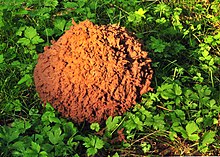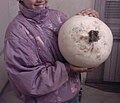Calvatia gigantea
| Giant puffball | |
|---|---|

| |
| Giant puffball with a Magellan eXplorist 200 GPS receiver for scale | |
| Scientific classification | |
| Kingdom: | |
| Phylum: | |
| Class: | |
| Order: | |
| Family: | |
| Genus: | |
| Species: | C. gigantea
|
| Binomial name | |
| Calvatia gigantea | |
| Synonyms | |
|
Langermannia gigantea | |
| Calvatia gigantea | |
|---|---|
| glebal hymenium | |
| no distinct cap | |
| hymenium attachment is not applicable | |
| lacks a stipe | |
| spore print is brown | |
| ecology is saprotrophic | |
| edibility: choice or inedible | |
Calvatia gigantea, commonly known as the giant puffball, is a puffball mushroom commonly found in meadows, fields, and deciduous forests usually in late summer and autumn. It is found in temperate areas throughout the world.[1]
Description[]
Most giant puffballs grow to be 10 to 50 centimetres (4 to 20 inches), sometimes to be 90 cm (35 in) in diameter; although occasionally some can reach diameters up to 150 cm (60 in) and weights of 20 kg (44 lb). The inside of mature giant puffballs is greenish brown, whereas the interior of immature puffballs is white. The large white mushrooms are edible when young.[2][3]
The fruiting body of a puffball mushroom will develop within the period of a few weeks and soon begin to decompose and rot, at which point it is dangerous to eat. Unlike most mushrooms, all the spores of the giant puffball are created inside the fruiting body; large specimens can easily contain several trillion spores. Spores are yellowish, smooth, and 3–5 μm in size.[2][3]
The classification of this species has been revised in recent years, as the formerly recognized class Gasteromycetes, which included all puffballs, has been found to be polyphyletic. Some authors place the giant puffball and other members of genus Calvatia in order Agaricales. Also, the species has in the past been placed in two other genera, Lycoperdon and Langermannia. However, the current view is that the giant puffball is Calvatia.[4]
Conservation status[]
The giant puffball is widespread and common in the UK. It is protected in parts of Poland and is of conservation concern in Norway.[1]
Cooking[]

All true puffballs are considered edible when immature, but can cause digestive upset if the spores have begun to form, as indicated by the color of the flesh being not pure white (first yellow, then brown). Immature gilled species still contained within their universal veil can be look alikes for puffballs. To distinguish puffballs from poisonous fungi, they must be cut open; edible puffballs will have a solid white interior.[5] Some similar mushrooms have the white interior (or yellowish) but also have the silhouette of a cap-type mushroom on the interior when cut open. These are young cap-type mushrooms and may be poisonous.
Medical uses[]
Puffballs are a known styptic and have long been used as wound dressing,[6] either in powdered form or as slices 3 cm thick. The fungus was often harvested prior to battles for this purpose.[7]
It is the main source of the anti-tumor mucoprotein , which is present only in tiny quantities.
Similar fungi[]
Giant puffballs resemble the earthball (Scleroderma citrinum). The latter are distinguished by a much firmer, elastic fruiting body, and having an interior that becomes dark purplish-black with white reticulation early in development. Scleroderma citrinum is poisonous and may cause mild intoxication.
Images[]

Giant puffball.

Puffball mushrooms on sale at a market in England, showing slices uniform and white all the way through.


Cut, with a fork for scale.

Giant puffballs growing in a deciduous forest
References[]
- ^ a b "Calvatia gigantea (giant puffball)", Discover plants and fungi, www.kew.org, archived from the original on 2016-12-22, retrieved 8 August 2015
- ^ a b Arora, David (1986). Mushrooms Demystified. Berkeley, California: Ten Speed Press. ISBN 978-0-89815-169-5.[page needed]
- ^ a b Bessette, Alan E. (1997). Mushrooms of Northeastern North America. Syracuse, NY: Syracuse University Press. ISBN 978-0-8156-0388-7.[page needed]
- ^ Volk, First. "Tom Volk's Fungus of the Month for August 1998". Retrieved 6 October 2012.
- ^ Meuninck, Jim (2017). Foraging Mushrooms Oregon: Finding, Identifying, and Preparing Edible Wild Mushrooms. Falcon Guides. p. 38. ISBN 978-1-4930-2669-2.
- ^ "Kew Botanica Gardens Calvatia Gigantea". Retrieved 11 July 2019.
- ^ Davies, Barry (2001). SAS mountain and arctic survival. London: Virgin. p. 87. ISBN 9780753505991.
Further reading[]
- Zhu, Wenyou; Guo, Chunxia; Luo, Fan (January 2015). "Optimization of Calvatia gigantea myceliaproduction from distillery wastewater". Journal of the Institute of Brewing. 121 (1): 78–86. doi:10.1002/jib.200.
- Kivrak, Ibrahim; Kivrak, Seyda; Harmandar, Mansur (1 September 2014). "Free amino acid profiling in the giant puffball mushroom (Calvatia gigantea) using UPLC-MS/MS". Food Chemistry. 158: 88–92. doi:10.1016/j.foodchem.2014.02.108. PMID 24731318.
- Coetzee, Johannes C.; Van Wyk, Abraham E. (January 2013). "Nomenclatural and taxonomic notes on Calvatia (Lycoperdaceae) and associated genera". Mycotaxon. 121 (1): 29–36. doi:10.5248/121.29. hdl:2263/21213.
External links[]
- Lycoperdaceae
- Fungi of Europe
- Fungi of North America
- Edible fungi
- Fungi found in fairy rings
- Puffballs
- Taxa named by August Batsch
- Taxa named by Christiaan Hendrik Persoon




